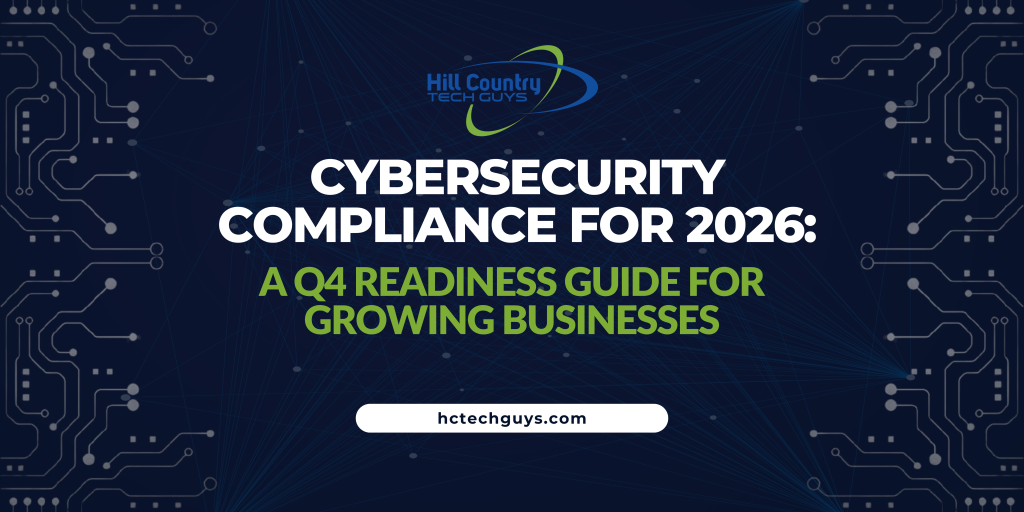As 2025 winds down, most companies are finalizing budgets, wrapping up projects, and planning for the year ahead. But one area that can’t wait until January is cybersecurity compliance.
Regulatory pressure is increasing, insurance requirements are tightening, and clients are asking tougher questions about how their vendors protect data. Compliance used to be a box you checked at renewal time. Today, it’s a continuous process that defines whether your business is secure, insurable, and trustworthy.
If 2025 was the year of catching up, 2026 is the year of proving it. And Q4 is the time to start preparing.
What Cybersecurity Compliance Means in 2026
Cybersecurity compliance refers to the policies, processes, and technical controls you put in place to meet security and privacy requirements, both legal and contractual.
That includes frameworks such as HIPAA, FTC Safeguards, NIST 800-53, and CMMC, depending on your industry and client base. Even if you’re not in a regulated sector, your cyber insurance policy likely requires documented protections and regular reviews.
The key shift going into 2026 is accountability.
Regulators, insurers, and clients are no longer satisfied with a signed policy. They expect proof that you actively maintain compliance through documented training, audits, and measurable outcomes.
In other words, compliance is no longer paperwork. It’s evidence.
Why Compliance Is Changing and Why 2026 Matters
Over the past year, new regulations have begun shaping what cybersecurity readiness means for small and midsized businesses:
- FTC Safeguards Rule: Now applies to many non-financial businesses that collect customer data, requiring risk assessments, encryption, and incident response plans.
- HIPAA Modernization Efforts: Healthcare providers and partners are expected to strengthen business associate agreements and records.
- Cyber Insurance Underwriting: Providers are tightening requirements for MFA, endpoint detection, and staff training logs.
By 2026, these expectations will not just be best practices. They will be the minimum standard for doing business securely.
Companies that wait to address compliance until they renew insurance or face an audit risk finding out too late that their processes don’t hold up.
Q4 is your window to get ahead of that curve.
The Cost of Waiting Until 2026
 Most businesses don’t skip compliance because they don’t care. They skip it because they are busy.
Most businesses don’t skip compliance because they don’t care. They skip it because they are busy.
But the cost of waiting is often higher than the cost of planning.
Here is what we have seen across industries:
- Delayed contracts: Clients increasingly require proof of security measures before signing or renewing agreements.
- Insurance denials: Missing controls, such as MFA or documentation, can result in rejected claims or higher premiums.
- Regulatory fines: Non-compliance with FTC, HIPAA, or data privacy laws can cost thousands per incident.
- Operational stress: Scrambling to document everything during an audit or renewal pulls teams off core work.
Planning now prevents the January scramble later and builds confidence with every vendor, insurer, and customer you work with.
How to Start Preparing in Q4 2025
You don’t need to rebuild your entire cybersecurity program this quarter, but you do need a plan.
Here are the first steps every business should take before the year ends:
1. Conduct a Compliance Gap Assessment
Start with an honest look at your policies, systems, and documentation.
- Are all your employees completing cybersecurity training annually?
- Do you have a written information security plan (WISP)?
- Are backups tested and verified?
- Can you show records of updates, permissions, and incident response testing?
2. Review Vendor and Partner Security
Compliance doesn’t stop at your network. Check who can access your systems. This includes vendors, contractors, and third-party applications. Make sure they meet your security standards.
3. Refresh Incident Response and Recovery Plans
If your incident response plan has not been tested in 12 months, schedule a tabletop exercise before year-end. These dry runs uncover process gaps long before a real event.
4. Document, Don’t Just Do
2026 will be the year of proof. Keep training logs, policy updates, and access control reviews in a central repository. Your MSP can help manage this. The more you can show your compliance story, the less you will have to explain it later.
Building Your 2026 Compliance Roadmap
Once you have identified gaps, you can build a quarterly plan that turns compliance from a project into a process.
2026 Cybersecurity Compliance Roadmap
Q4 2025 · Assess
Identify gaps, update WISP, plan budgets.
Q1 2026 · Remediate
Implement missing controls and document fixes.
Q2 2026 · Verify
Run audit simulations and collect reports.
Q3 2026 · Optimize
Review outcomes, refine training and reporting.
By the end of 2026, you should have a clear, defensible record of your security posture. Not just a stack of policies, but an ongoing practice of risk management.
This approach also makes annual insurance renewals and audits far easier because you’re never starting from scratch.
The Role of Your MSP in Compliance Readiness
Most compliance frameworks require the same foundational elements:
- Regular patching and system updates
- Secure backups
- Access control and MFA
- Endpoint protection and monitoring
- Documentation and reporting
Your managed service provider (MSP) can serve as your technology compliance partner, not just a helpdesk.
At Hill Country Tech Guys, we integrate compliance into your daily IT operations, from monitoring and maintenance to documentation and reporting.
That means:
- You can prove what you’re already doing right.
- You can fix gaps proactively instead of reactively.
- You have a partner who understands both the technical and strategic sides of compliance.
Compliance isn’t about adding work. It’s about ensuring the work you’re already doing is documented, defensible, and aligned with business goals.
2026 Cybersecurity Compliance Checklist
Use this simplified interactive checklist to guide your year-end review:
2026 Cybersecurity Compliance Checklist
Tip: click to check items off. Progress is not saved after reload.
Each box you check off strengthens your defensible compliance posture and proves that your organization isn’t only aware of risk but actively managing it.
FAQs about Cybersecurity Compliance
What frameworks apply to SMB cybersecurity compliance in 2026?
Common frameworks include HIPAA for healthcare, the FTC Safeguards Rule for financial and consumer data, NIST 800-53 for general security controls, and CMMC for defense contractors. Even unregulated businesses should align with at least one framework for cyber-insurance eligibility.
Why does Q4 matter for compliance planning?
Q4 is when most companies set budgets and finalize technology plans. Starting compliance work now allows teams to remediate gaps, document controls, and enter 2026 ready for audits and insurance renewals.
How can a managed service provider help with cybersecurity compliance?
An MSP like Hill Country Tech Guys manages the technical side of compliance—patching, monitoring, MFA enforcement, and reporting—while guiding your organization through documentation and training so every control is both active and auditable.
Compliance as Confidence
The businesses that treat compliance as an annual audit exercise will always feel behind. Those who treat it as a living practice will build trust, qualify for better insurance rates, and avoid costly disruptions.
Q4 is your opportunity to shift from reactive to ready. 2026 will reward the companies that plan ahead, and your future clients, insurers, and auditors will thank you for it.
Start with a 2026 plan you can prove. Contact Hill Country Tech Guys to begin your compliance rediness review.




